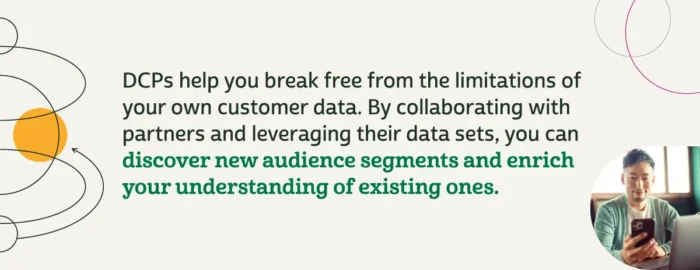The death of third-party cookies has ushered in a new era for marketers: the age of anonymity. Reaching and understanding your audience has become a challenge, with a growing disconnect between the data you have and the vast pool of anonymous consumers. This is where using a data collaboration platform (DCPs) and the following DCP use cases can help.
DCPs, or Data Collaboration Platforms, empower you to bridge the addressability gap. They unlock a world of possibilities, allowing you to craft targeted campaigns, personalize experiences, and gain valuable customer insights – even when faced with anonymous audiences.
This guide uncovers powerful data collaboration platform use cases for marketers, showcasing how these platforms can transform your marketing strategy in a privacy-focused landscape. Here’s a deeper dive into 5 DCP use cases for marketers looking to overcome the challenges presented by the addressability gap:
DCP Use Case 1: Customer Insights
Understanding your current customer base is critical for successful marketing. DCPs provide powerful analytics that go beyond basic metrics, offering a richer picture of who your customer is, outside of their direct engagement with your brand. Lotame’s Data Collaboration Platform (DCP), Spherical, exemplifies this with built-in audience dashboards that inform a multidimensional view of your customer.

- Audience Discovery: DCPs allow brands to uncover the intersection of their first-party audience with external data sources (trusted second and third-party data). This will surface demographic, behavioral and intent attributes that will inform more relevant creative messaging, contextual categories and new audience personas to target necessary for effective customer acquisition strategies.
- Campaign Measurement: Marketing campaigns often involve multiple touchpoints across different platforms, domains and devices. Data collaboration platforms can help marketers understand the profile of prospective buyers across each digital media touchpoint. Armed with a better understanding of what their ideal customer looks like, based on those exhibiting a desired KPI, brands can optimize their marketing spend and allocate resources effectively.
- Customer Journey Insights: DCPs enable brands to compare the audience composition across different consumer journey milestones. This data-driven approach ensures you’re delivering the most impactful messaging that drives bottom-of-the-funnel results.
Real-world Example: A grocery store that has seen a drop off in its loyal consumer in-store purchases might take advantage of a DCP like Spherical. They use our analytics suite to uncover new attributes about loyalty card members, who favor organic products. This drives a personalized campaign, offering exclusive discounts on organic goods to a subset of their loyalty card members resulting in a lift in store sales.
DCP Use Case 2: Personalized Marketing
Personalization is no longer a luxury – it’s an expectation. According to the IAB Consumer Privacy Report, 88% of consumers prefer ads that are for products or services that they are interested in or shopping for. DCPs provide marketers with deep customer insights that can be used to personalize content, offers, and experiences for each customer, fostering stronger relationships.

- Product Recommendations: Gain a more holistic view of your customer by analyzing first-party data from various sources. This combined data provides a richer understanding of customer behavior, preferences, and buying habits.
- Improved customer lifetime value: By offering relevant products and services, brands can increase customer satisfaction and loyalty. This, in turn, leads to a higher customer lifetime value (CLV) – the total amount a customer spends with a company over their relationship.
By analyzing demographics, purchase history, and website behavior, DCPs can help you understand your audience better. These insights can then be used to personalize content across various channels.
Real-world Example: Imagine a clothing company partnering with a loyalty program company. They can see what shoes customers typically buy with a certain type of dress, allowing for more targeted cross-selling recommendations.
DCP Use Case 3: Paid Media Audience Targeting
Imagine creating advertising campaigns that resonate deeply with a niche audience segment, like young professionals interested in sustainable fashion. DCPs allow marketers to achieve this level of precision through advanced segmentation.
- Audience Segmentation: Move beyond basic demographics like age and location. DCPs, like Lotame’s Spherical platform, allow you to segment audiences based on interests (e.g., following sustainable fashion brands on social media), purchase behavior (e.g., past purchases of eco-friendly clothing), and even browsing behavior (e.g., visiting websites related to organic cotton production).
- Build Lookalike Audiences: Do you have a loyal customer base? DCPs can deploy machine learning to dynamically identify attributes that are shared across your customers to build “lookalike audiences.” This unlocks a more efficient way to engage net new prospects.
Real-world Example: A CPG brand that sells 10 percent of its product online might leverage a DCP to generate a lookalike audience from its digital sales, removing recent purchasers. The lookalike audience can be tuned for optimal scale without sacrificing precision. In many cases, these audiences outperform off-the-shelf targeting on social platforms.
DCP Use Case 4: Extend Your Reach and Enrich Your Understanding
DCPs help you break free from the limitations of your own customer data. By collaborating with partners and leveraging their data sets, you can discover new audience segments and enrich your understanding of existing ones.
- Data Collaboration: By securely sharing and integrating data with trusted partners through DCPs, marketers can discover new audience segments with unique characteristics and behaviors. This collaboration allows for a more comprehensive understanding of existing customers, revealing hidden insights that might be missed with just your own data.
- Data Enrichment: Collaboration allows brands to access a wider pool of data, beyond the limits of their first-party, providing a more complete picture and uncovering hidden trends they might have missed with their own data set. Combine your first-party data (e.g., customer purchase history) with second- and third-party data sources (e.g., demographics, intent, psychographics, contextual).
- Audience Extension: Marketers can utilize identity to find existing customers across devices and domains to diversify touch points. This can power omnichannel executions, and engage customers in new channels. A brand can now retarget its customers in CTV environments, for example.

Real-world Example: A brick-and-mortar clothing retailer partners with a local gym through a DCP. By analyzing anonymized customer data, they discover a segment of gym members who are also interested in athletic wear. This allows them to develop targeted marketing campaigns to reach this specific audience segment, resulting in increased sales.
DCP Use Case 5: Data Activation
Data is only valuable if you put it to work. DCPs with a leading identity spine like Lotame’s Spherical, unlock cookieless activation at scale. Activate with hundreds of connections to the digital ecosystem, all from one platform.
- Omnichannel Marketing: Bridge the gap between data and action. You can leverage audience insights to deliver targeted ads, emails, and personalized content across various channels. Lotame allows you to do all this using cookieless identifiers like Mobile Advertising IDs (MAIDS), CTV IDs, as well as extending addressability with Lotame’s Panorama ID, our hybrid deterministic and probabilistic solution that unlocks cookieless activation at scale. All of this ensures consistent messaging and a unified customer experience, in a world with or without third-party cookies.
- Retargeting: Allow brands to reach users who’ve already shown interest in their products or services without a dependency on third-party cookies through traditional execution. This means the ads are more likely to be relevant, capturing the user’s attention and sparking engagement. Studies show retargeting can increase ad engagement by over 400%!

Real-world Example: A beauty brand might leverage a DCP to target relevant audiences on CTV platforms. They collaborate with partners to enrich their data and use cookieless activation to reach users without relying on third-party cookies. This allows them to create targeted CTV ad campaigns, reaching existing customers and new audiences with relevant messaging.
The Lotame Solution
In today’s data-driven marketing landscape, extracting actionable insights from the vast amount of customer data available is crucial for success. Marketers need a platform that empowers them to understand their audience, personalize experiences, and activate campaigns across various channels. This is where Lotame’s Data Collaboration Platform (DCP) comes in.
Lotame’s Spherical platform is the be-all-end-all data collaboration platform for customer acquisition and audience expansion. Spherical empowers you with everything you need, from gaining deep customer insights to creating targeted segments, crafting personalized messaging, and activating campaigns across various channels.
Don’t settle for just managing data; unlock its full potential with Lotame. Take control of your marketing and achieve your goals with the power of data collaboration. Connect with us today to learn more.